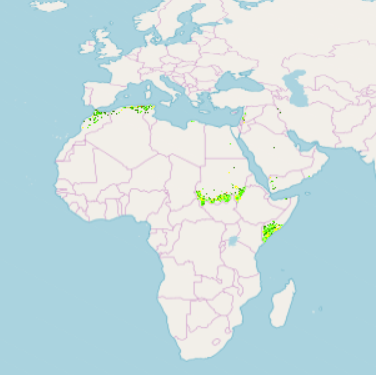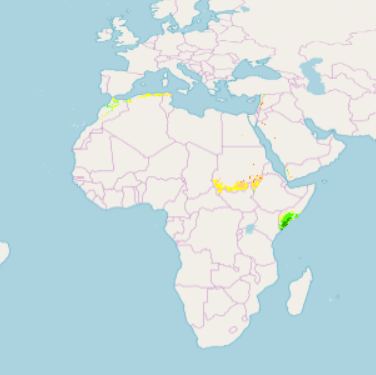Exposure Indicators
Type of resources
Available actions
Topics
Keywords
Provided by
Years
Formats
Representation types
Update frequencies
status
-

This raster grid provides a representation of the exposure (vulnerability assessment) for climate change impact sector:subsector – People: Water Available for Drinking - in the Middle East and North Africa Region, 1986-2005 reference period. Vulnerability is a concept used to express the complex interaction of climate change effects and the susceptibility of a system to its impacts. In the context of climate change, exposure refers to changes in climate parameters that might affect socio-ecological systems. The integrated vulnerability assessment combines a series of single vulnerability assessments for several water-related climate change impacts on different sectors. It adopts the time periods generally used by the Intergovernmental Panel for Climate Change (IPCC) and other regional climate modelling experiments, and runs climate simulations based on future time periods that are compared with a historical reference period. The raster grid (GeoTiff raster file) is available for 1986-2005 reference period at approximately 1km pixel resolution. Pixel values were classified according to level of exposure, from low 1 to high 10, for the sector:subsector: People: Water Available for Drinking.
-

Part of the Integrated Vulnerability Assessment in the Arab Region, this 1km pixel resolution raster dataset provides a representation of Sensitivity to climate change for impact sector:subsector – Agriculture: Water Available for Livestock - in the Middle East and North Africa Region. Vulnerability is a concept used to express the complex interaction of climate change effects and the susceptibility of a system to its impacts. The integrated vulnerability assessment methodology is based on an understanding of vulnerability as a function of a system’s climate change exposure, sensitivity and adaptive capacity to cope with climate change effects, consistent with the approach put forward by the Intergovernmental Panel on Climate Change (IPCC) in its Fourth Assessment Report (AR4). Within this conceptual framework, Sensitivity provides information about the status quo of the physical and natural environment that makes the affected systems particularly susceptible to climate change. The integrated vulnerability assessment combines a series of single vulnerability assessments for several water-related climate change impacts on different sectors. A class value of 1 was assigned to represent a favorable condition (low sensitivity) while a class value of 10 designates an unfavorable condition.
-

Part of the Integrated Vulnerability Assessment in the Arab Region, this 1km pixel resolution raster dataset provides a representation of change in Potential Impact, for climate change impact sector:subsector – Biodiversity and Ecosystems: Area Covered by Forests - in the Middle East and North Africa Region. Vulnerability is a concept used to express the complex interaction of climate change effects and the susceptibility of a system to its impacts. Within the Vulnerability Assessment conceptual framework, Exposure refers to changes in climate parameters that might affect socio-ecological systems, Sensitivity provides information about the status quo of the physical and natural environment that makes the affected systems particularly susceptible, and the Potential Impact is determined by combining the exposure and sensitivity of a system. The integrated vulnerability assessment combines a series of single vulnerability assessments for several water-related climate change impacts on different sectors. It adopts the time periods generally used by the Intergovernmental Panel for Climate Change (IPCC) and other regional climate modelling experiments, and runs climate simulations based on future time periods that are compared with a historical reference period. The raster grids, with classified pixel values, from low Potential Impact 1 to high Potential Impact 10, are generated for moderate and high representative concentration pathways (RCP4.5 and RCP8.5), emission scenarios developed by the Intergovernmental Panel on Climate Change (IPCC) for informing climate modelling work, and for future time periods: Mid-Century (2046-2065); End-Century (2081-2100).
-

RICCAR, MENA Region - Vulnerability Assessment - Exposure Indicators, RCM Output (Reference Period) This raster dataset provides a representation of the exposure indicators derived from climate modelling outputs in the Middle East and North Africa Region, for the 1986-2005 reference period. In the context of climate change, exposure refers to changes in climate parameters that might affect socio-ecological systems. The Regional Climate Model (RCM) ensemble adopts the time periods generally used by the Intergovernmental Panel for Climate Change (IPCC) and other regional climate modelling experiments. It runs climate simulations based on three future time periods that are compared with a historical reference period. The grids (GeoTiff raster files) are available for 1986-2005 reference period at approximately 1km pixel resolution. Pixel values were classified according to level of exposure, from low 1 to high 10, for each of the indicators: Maximum length of wet spell, Precipitation, Simple precipitation intensity index, Number of summer days, Number of hot days, Number of very hot days, Temperature, Number of tropical nights.
-

This raster dataset provides a representation of the change in exposure (vulnerability assessment) for climate change impact sector:subsector - Agriculture: Water available for Livestock - in the Middle East and North Africa Region. Vulnerability is a concept used to express the complex interaction of climate change effects and the susceptibility of a system to its impacts. In the context of climate change, exposure refers to changes in climate parameters that might affect socio-ecological systems. The integrated vulnerability assessment combines a series of single vulnerability assessments for several water-related climate change impacts on different sectors. It adopts the time periods generally used by the Intergovernmental Panel for Climate Change (IPCC) and other regional climate modelling experiments, and runs climate simulations based on future time periods that are compared with a historical reference period. The adopted future time periods are: Mid-Century (2046-2065); End-Century (2081-2100). Available at approximately 1km pixel resolution, the raster grids are generated for moderate and high representative concentration pathways (RCPs), emission scenarios developed by the Intergovernmental Panel on Climate Change (IPCC) for informing global and regional climate modelling work (RCP4.5 and RCP8.5). Grid pixel values are classified according to a level of exposure (1 to 10), for the sector:subsector: - Agriculture: Water Available for Livestock;
-

This raster dataset provides a representation of the exposure indicators derived from hydrological model Variable Infiltration Capacity (VIC) in the Middle East and North Africa Region, for the reference period 1986-2005. In the context of climate change, exposure refers to changes in climate parameters that might affect socio-ecological systems. Using on the open-source hydrological model VIC and bias-corrected Regional Climate Models (RCM) results as inputs, the Regional Hydrological Model (RHM) ensemble is employed to assess hydrological change based on future climate projections. The RHM ensemble adopts the same time periods used by the Intergovernmental Panel for Climate Change (IPCC) and other regional climate modelling experiments. It runs climate simulations based on three future time periods that are compared with a historical reference period. Available at approximately 1km pixel resolution, for 1986-2005 reference period, the raster grids are generated for moderate and high representative concentration pathways (RCPs), emission scenarios developed by the IPCC for informing global and regional climate modelling work (RCP4.5 and RCP8.5). Grid pixel values are classified according to a level of exposure (1 to 10), for the indicators, Evapotranspiration and Runoff.
-

This raster dataset provides a representation of future levels of exposure to extreme climate events in the Middle East and North Africa Region. In the context of climate change exposure refers to changes in climate parameters that might affect socio-ecological systems. The Regional Climate Model (RCM) ensemble adopts the time periods generally used by the Intergovernmental Panel for Climate Change (IPCC) and other regional climate modelling experiments. It runs climate simulations based on three future time periods that are compared with a historical reference period. Available at approximately 1km pixel resolution, for future time periods; Near, Mid and End-century, the raster grids are generated for moderate and high representative concentration pathways (RCPs), emission scenarios developed by the IPCC for informing global and regional climate modelling work (RCP4.5 and RCP8.5). Grid pixel values are classified according to a level of exposure (1 to 10), for each of the extreme events indices: Maximum length of dry spell; Annual count of 10mm precipitation days; Annual count of 20mm precipitation days. The adopted time periods are: Near-Century (2016-2035); Mid-Century (2046-2065); End-Century (2081-2100).
-

This raster dataset provides a representation of the change in exposure (vulnerability assessment) for climate change impact sector:subsector - People: Water Available for Drinking - in the Middle East and North Africa Region. Vulnerability is a concept used to express the complex interaction of climate change effects and the susceptibility of a system to its impacts. In the context of climate change, exposure refers to changes in climate parameters that might affect socio-ecological systems. The integrated vulnerability assessment combines a series of single vulnerability assessments for several water-related climate change impacts on different sectors. It adopts the time periods generally used by the Intergovernmental Panel for Climate Change (IPCC) and other regional climate modelling experiments, and runs climate simulations based on future time periods that are compared with a historical reference period. The adopted future time periods are: Mid-Century (2046-2065); End-Century (2081-2100). Available at approximately 1km pixel resolution, the raster grids are generated for moderate and high representative concentration pathways (RCPs), emission scenarios developed by the Intergovernmental Panel on Climate Change (IPCC) for informing global and regional climate modelling work (RCP4.5 and RCP8.5). Grid pixel values are classified according to a level of exposure (1 to 10), for the sector:subsector: - People: Water Available for Drinking.
-

This raster dataset provides a representation of the change in exposure (vulnerability assessment) for climate change impact sector:subsector - Water: Water Availability - in the Middle East and North Africa Region. Vulnerability is a concept used to express the complex interaction of climate change effects and the susceptibility of a system to its impacts. In the context of climate change, exposure refers to changes in climate parameters that might affect socio-ecological systems. The integrated vulnerability assessment combines a series of single vulnerability assessments for several water-related climate change impacts on different sectors. It adopts the time periods generally used by the Intergovernmental Panel for Climate Change (IPCC) and other regional climate modelling experiments, and runs climate simulations based on future time periods that are compared with a historical reference period. The adopted future time periods are: Mid-Century (2046-2065); End-Century (2081-2100). Available at approximately 1km pixel resolution, the raster grids are generated for moderate and high representative concentration pathways (RCPs), emission scenarios developed by the Intergovernmental Panel on Climate Change (IPCC) for informing global and regional climate modelling work (RCP4.5 and RCP8.5). Grid pixel values are classified according to a level of exposure (1 to 10), for the sector:subsector: - Water: Water Availability.
-

RICCAR, MENA Region - Vulnerability Assessment - Exposure Indicators, RCM Output (Future) This raster dataset provides a representation of future level of exposure for the indicators derived from regional climate modelling (RCM) outputs, in the Middle East and North Africa Region. In the context of climate change, exposure refers to changes in climate parameters that might affect socio-ecological systems. The RCM ensemble adopts the time periods generally used by the Intergovernmental Panel for Climate Change (IPCC) and other regional climate modelling experiments. It runs climate simulations based on three future time periods that are compared with a historical reference period. Available at approximately 1km pixel resolution, for future time periods; Near, Mid and End-century, the raster grids are generated for moderate and high representative concentration pathways (RCPs), emission scenarios developed by the IPCC for informing global and regional climate modelling work (RCP4.5 and RCP8.5). Grid pixel values were classified according to level the of exposure (1 to 10) for each of the indicators: Maximum length of wet spell; Precipitation; Simple precipitation intensity index; Number of summer days; Number of hot days; Number of very hot days; Temperature; Number of tropical nights. The adopted time periods are: Near-Century (2016-2035); Mid-Century (2046-2065); End-Century (2081-2100).
 FAO Map Catalog
FAO Map Catalog